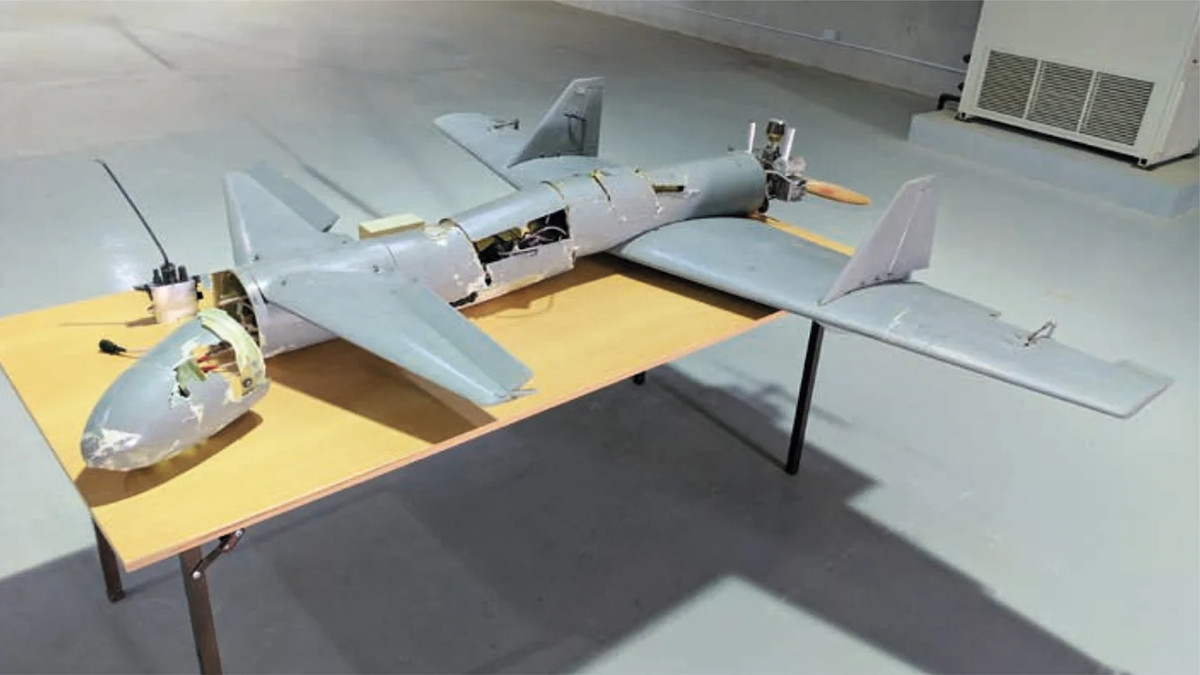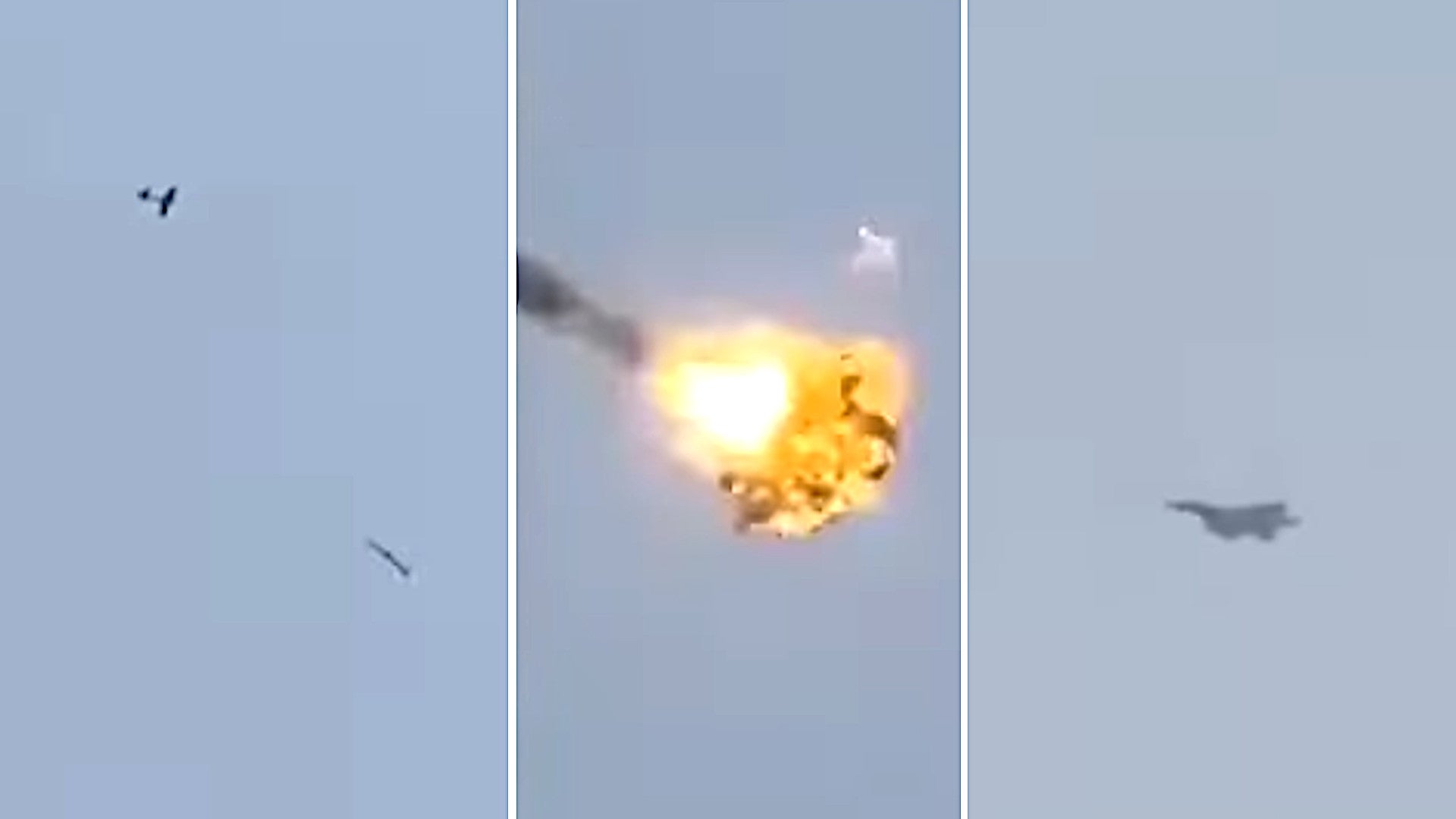Iranian-backed Houthi rebels in Yemen launching suicide drones, as well as ballistic and cruise missiles, at targets in Saudi Arabia has become a regular occurrence. Announcements about interceptions by Royal Saudi Air Force F-15 fighter jets, as well as Patriot surface-to-air missiles, very costly responses to these relatively cheap threats, have become equally routine. However, video footage has now emerged online offering a different kind of look at this ongoing duel as Saudi troops on the ground watch an F-15 swoop in a relatively low level to knock down a Houthi Qasef-series suicide drone.
The video begins with individuals on the ground watching the Qasef flying along above, with its engine humming loudly. A missile is then seen flying in underneath the drone. The missile detonates after coming within a certain distance of the unmanned aircraft, causing it to fall out of the sky. An F-15, which looks to have launched the missile, then comes zooming into view. The Saudis operate a number of different Eagle variants and it’s not possible to tell at the distance the video was shot which version is seen in this case.

It’s not clear what kind of missile was employed in this case, but based on what can be seen in the video, it might have been an active radar-homing AIM-120 Advanced Medium-Range Air-to-Air Missile (AMRAAM). It’s unclear why this weapon would have been chosen over a missile that might have been better suited to engaging targets at shorter ranges like this, such as an AIM-9 Sidewinder. The target’s thermal or radar signature and aspect, as well as what weapons are available or in plentiful supply in terms of Saudi stocks, may have played a part in weapons selection.

In addition, there are no clear indications as to when or where this clip was shot, but, toward the end, it cuts to an individual wearing a uniform in what appears to be a camouflage pattern commonly associated with Saudi Arabia’s Border Guards. This camouflage uniform is distinct from the ones worn by members of the Royal Saudi Land Forces or the Saudi Arabia National Guard (SANG).
That Saudi Border Guards would have witnessed this exchange is very reasonable given that many Houthi attacks on Saudi Arabia target sites right across the country’s southern border with Yemen. The Houthis have also launched missile and drone strikes against facilities much deeper inside Saudi territory, or at least claims to have, in certain instances. The group said it was responsible for unprecedented drone and missile strikes against Saudi oil infrastructure in 2019, but the U.S. government subsequently blamed Iran directly for carrying out that operation.
The Qasef-1, a suicide drone derived from the Iranian Ababil-2, and the improved Qasef-2K, are Houthi staples that the Yemeni rebels have been actively using for years now. The exact differences between the Qasef-1, which has an estimated range of around 124 miles, and the Qasef-2K are not entirely clear.

The Qasef-series is also only one of a number of different suicide drone types that the Houthis now operate. Earlier this month, the group held a glitzy arms fair in which they showed off a wide assortment of drones, including fixed-wing and hexcopter types purportedly able to drop improvised munitions, as well as various ballistic and cruise missiles, naval mines, small arms, and other light weapons.

As already noted, as time has gone on, the Saudis have become relatively proficient at intercepting Houthi drones, as well as the group’s missiles. However, the cost ratio for these engagements, even when they are successful, is firmly on the side of the Yemeni rebels.
For instance, the Pentagon has estimated that the Air Force will pay $29,000 per flight hour to operate its new F-15EX fighter jets. The F-15EX is derived from the F-15QA for Qatar, which itself was based on the configuration of the Saudi F-15SA. In addition, each AIM-120C, the version of the AMRAAM that the Saudis use, cost around $1 million, while AIM-9X Sidewinders have average unit costs in the region of between $430,000 to $470,000. Houthi Qasef-series drones cost, at most, a couple of thousand dollars to produce.
The video below is a montage of clips, shot from targeting pods on F-15s, that the Saudi government has previously released of interceptions of Houthi drones.

Of course, this problematic cost differential is not new. In 2017, a U.S. Army general had publicly talked about this issue, describing how an unspecified U.S. ally, possibly Israel, had shot down a quadcopter-type drone of the kind anyone can purchase online for hundreds of dollars with a Patriot missile worth millions.
More recently, U.S. Marine Corps General Frank McKenzie, the current head of U.S. Central Command (CENTCOM), has said on multiple occasions he believes that small drones represent a growing, outsized threat relative to their cost and that the U.S. military is presently on the “wrong side” of that equation. The U.S. military is very likely watching closely how Saudi Arabia deals with Houthi drones, as well as their cruise missiles, as it works to refine and expand its own capabilities to engage similar threats, especially in airspace over and around the United States.
Those developments aside, the U.S. military, among many others, is still very much grappling now with how to counter these very real threats in a cost-effective manner. This, together with the relatively low monetary and skill barriers to the employment of lower-end drones, including hobbyist types modified to carry improvised munitions, to begin with, makes them very attractive to non-state actors, including terrorists and organized criminal enterprises. Spending millions of dollars to defeat a steady stream of drones that cost thousands of dollars is just not a sustainable proposition in the long term.
This is certainly a reality that Saudis will only have increasingly contend with, especially as the Houthis have been notably stepping up drone and missile attacks on the Kingdom in recent months. Just last week, the group said it had hit various facilities belonging to Saudi Arabia’s military security forces, as well as oil and other energy industry-related sites, with a total of 18 drones. The escalating rebel attacks have also included the targeting of ships off the country’s coast using mines and remote-control explosive-laden boats.
“We are prepared to carry out stronger and harsher military attacks in the coming period,” Yahya Sarea, a Houthi military spokesman, wrote on Twitter after the mass drone attack last week.
That statement came after the Iranian-backed group rejected a proposed Saudi peace plan. Continuing Houthi attacks on Saudi Arabia, as well as inside Yemen, have also frustrated attempts by President Joe Biden’s administration in the United States to push for a diplomatic solution to the brutal conflict in the country, which has been raging since 2015.
The U.S. government announced in February that it had stopped supporting Saudi-led “offensive” operations against the Houthis, which it also delisted as a designated terrorist group, as part of this effort. However, American officials did say that they would continue to help the Kingdom protect itself against the group’s attacks.
In the meantime, the Saudis look set to have to continue to engage in this costly duel with the Houthis.
Contact the author: joe@thedrive.com
